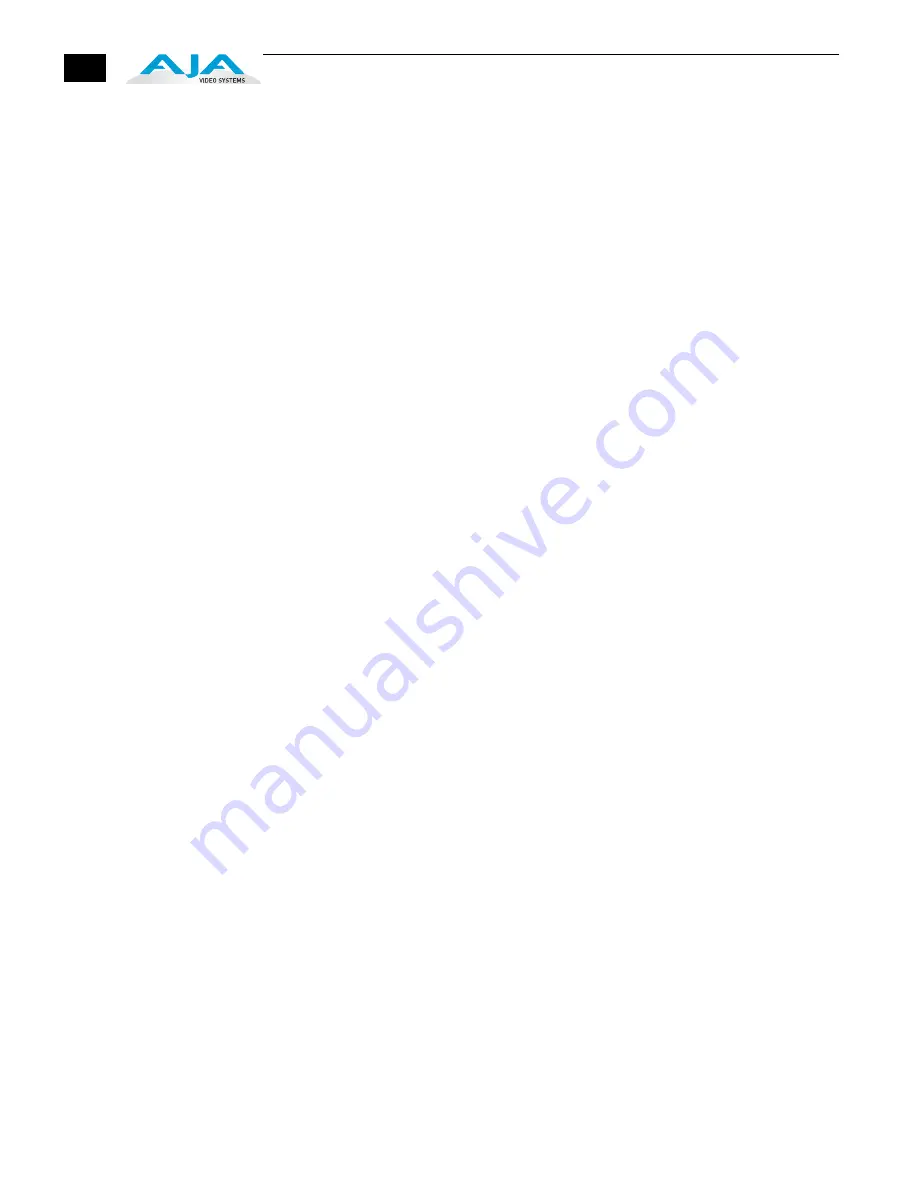
30
Note:
The KONA Control Panel also works with other KONA cards, Io HD and Io Express.
However, the actual features and screens displayed differ slightly since the board
feature sets differ.
Before we go into too much detail, here are some basic definitions you should know (please
refer to the figure that follows for reference). After studying the basics, read “
Who is
Controlling KONA LHi
?” later in this chapter for more advanced information on how
applications interact with the KONA LHi board.
Tabbed Screens
—the bottom area of the AJA Control Panel provides different information
categorized by topic. Clicking on one of the “Tab” items from the left navigation
column will result in an information screen corresponding to that tab’s topic. Each of
these tabbed windows are described on the following pages.
Tabs screens available are:
Control:
configures the default output (test pattern, pass through, desktop,
etc.) plus setting genlock and output timing.
Format:
select the framebuffer primary video format, any secondary.
formats, and parameters of up/down/crossconversion for input/output.
Input Select:
view and edit input selections and how they are mapped.
SDI Output:
assign outputs to either Primary or Secondary formats.
HDMI:
configure the HDMI input and output
Analog Output:
configure the component/comY/C analog output.
Video Setup:
configures Video options such as composite black level.
Audio Setup:
configures analog audio monitor level and delay.
Conversion:
used to select codec options such as whether paused video
appears as a full frame or a single field (jitter shown or not shown) and 24
to 30 fps padding patterns.
DS Keyer:
select downstream keyer mode, specify a graphic file or matte.
Timecode:
monitor RP-188 timecode and configure timecode window burn
output (
Note:
SMPTE 12M-2 is the updated name and specification for
what was RP-188)
Timelapse:
enables the capture of select frames over a specified time interval.
Info:
displays status information about the KONA. This information is
generally intended for troubleshooting and support.
Block Diagram Screen
—the top area of the AJA Control Panel shows a visual picture
representing the processing (if any) that's currently occurring, including inputs/
outputs, any up/down/cross conversion, reference source, and system status. Lines
between inputs, the framebuffer, and outputs, show a video path. Where there are no
lines, it shows there is no connection; this can be either because an input or output
isn't selected or because no video is present at the selected input.
Icon objects on the block diagram screen (input/output icons, frame buffer, etc.-also
called “widgets”-indicate their status by color (explained later) and when clicked will
bring up the proper tabbed screen used to configure that item. For example, clicking
on an SDI output icon will cause the “SDI Output” tab screen to be displayed below the
block diagram. With the mouse on a block diagram element, you can also control click
to reveal contextual drop down menus for certain functions.
Text Color
—Colored text in the block diagram provides an indication of signal type and
what the KONA LHi is doing. Text in blue shows the values automatically selected,
while text in black shows values that have been manually selected. Text in red shows
that the KONA is not detecting a signal or cannot negotiate with the attached device
(even if it can’t detect an output device, it still shows the signal it is outputting).
Summary of Contents for KONA LHI
Page 4: ...iv ...
Page 18: ...12 ...
Page 24: ...18 ...
Page 74: ...68 ...
Page 78: ...70 ...
Page 82: ...A 4 ...
Page 86: ...I 4 Yellow 34 YPbPr 11 YUV 11 Z Zoom 14 9 38 Zoom Letterbox 38 Zoom Wide 38 ...
















































